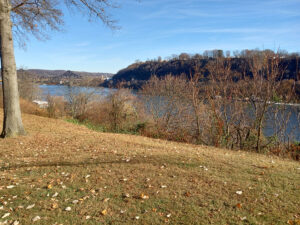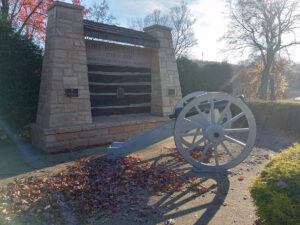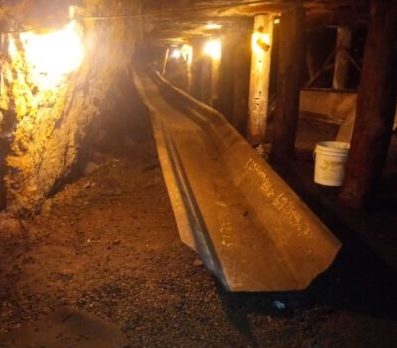Last fall, prompted by rumors of an art gallery featuring Impressionists, we embarked on a discovery tour of some Ohio River valley communities. We found new world history, imaginative play, sweet family memories, and quiet moments to reflect on the Word.
Our trip was, initially, to the Merrick Art Gallery in New Brighton (Beaver County). Housed in an old railroad station, it provides the opportunity to see the private art collection of a local American entrepreneur. Edward Dempster Merrick was born in 1832 and read books about Renaissance artists as a young child, rousing a desire to become an artist himself. Discouraged by family, Merrick became a telegraph operator, served in the Civil War, opened a foundry, and received two patents. Yet through all this, he did not abandon his love of art and finally pursued his dream when he was 53. He founded the Merrick Art Gallery to ensure that the working class could freely experience art without the expense and difficulty of travel to a museum in a large city like New York–more than a decade before industrialists Andrew Carnegie and Henry Clay Frick decided to open their own art museums. The gallery contains the artworks he collected, but not his own (according to legend, his surviving family did not appreciate them and disposed of them). Being a philanthropic polymath, Merrick also donated vast collections of butterflies, bugs, rocks, and minerals to the Merrick Art Gallery and the Smithsonian Institution.

The Merrick Art Gallery in New Brighton includes collections of American landscapes, impressionists, and other artwork as well as antiques.
I took our budding polymaths to this donation-based gallery and admired the artwork (although my young children were more fascinated by displays of instruments, antique toys, model houses, and military memorabilia). I loved the collection—although there was a wide range of subject matter, a significant number of the paintings portrayed mothers and families and highlighted the precious “imperishable beauty of a gentle and quiet spirit” (1 Peter 3:4) and how pleasing it is “when brothers dwell in unity” (Psalm 133:1). I also noticed many artworks with titles such as “Ideal Head”—and the vast differences between the models. What a stark contradiction to the modern and narrowly defined ideal of beauty! What an important lesson to teach our children about the uniqueness and beauty in each person God created! I can’t say I’ve ever observed these themes in a major art museum’s collection, so I cherished the opportunity to discuss with my children what the Word of God says about families and true beauty.
When my toddler started rolling across the gallery floor, I wrapped up my meditations and walked (as slowly as possible) to the exit. I look forward to coming here often to be reminded of these eternal truths that are so easily drowned out in today’s world.
It being only lunchtime, we decided to explore what else the town had to offer. And who wouldn’t want a sweet stopover at Rosalind’s Candy Castle, Beaver County’s oldest confectionary? Founded in 1914 by a Greek immigrant with a passion for high quality confections, the current owners carry on Gust Zachos’ legacy by using real butter and dairy cream, rather than cheaper alternatives found in other chocolate brands. Rosalind’s Candy Castle ceased giving tours of the kitchen a few years ago, but we were welcomed to stand in the doorway and watch the chocolate being made while the saleslady kindly described to us everything that was happening. We came home with lots of delicious Christmas gifts and it required a spirit of self-control to not eat them on my own . . .well, most of them. . .

We were blessed with a special opportunity to see and pet some of this year’s calves at Broadrun Farms in Beaver Falls.
It is worth mentioning two other sweet businesses in Beaver Falls within ten minutes of the Merrick Art Gallery. The first is Broadrun Farms, which sells so many delicious foods in its farm store (including what my family has deemed the very best chocolate milk). We have known this incredible family now for two generations and have been blessed to frequently visit their organic, pastured dairy. The other business is Oram’s Donuts, which is very highly praised by other homeschooling families we know. When you come, be sure to check operating hours for any sites and businesses you wish to visit so that you don’t make our mistake of arriving at Oram’s after they’ve closed for the day. We’ll just have to return again!
Our last stop was across the river at Fort McIntosh in Beaver. We enjoyed gorgeous views of the Ohio River and the railroads along it as we ate our lunch. The fort itself is gone, with only a few foundation stones and many informative placards in its stead (and a cannon, which of course inspired plenty of imaginative play). Perched on the edge of a cliff, this log fort was the first fort built by the new United States of America north of the Ohio River and is considered the first permanent post of the United States Army. It was the location for the signing of a 1785 treaty whereby the Delaware tribe gave lands over to the new American nation, setting the stage for future treaties with the native populations. The fort was decommissioned in 1788 yet served as one of the overnight stops of the Lewis and Clark expedition in 1803 (other Pennsylvania stops included Fort Pitt and Old Economy Village further upstream).
This did not mark the end of the nearby attractions, but it did mark the end of our rations and our spontaneous day-trip. In a future trip, we hope to add visits to the nearby Air Heritage Museum, the Beaver Area Heritage Museum and 1802 Log House, the Captain William Vicary Mansion, and some scenic hikes. We’ll enjoy delicious foods and refresh our souls with an artistic reminder of the wonderful blessing of family and a gentle spirit as we make some sweet memories together.






